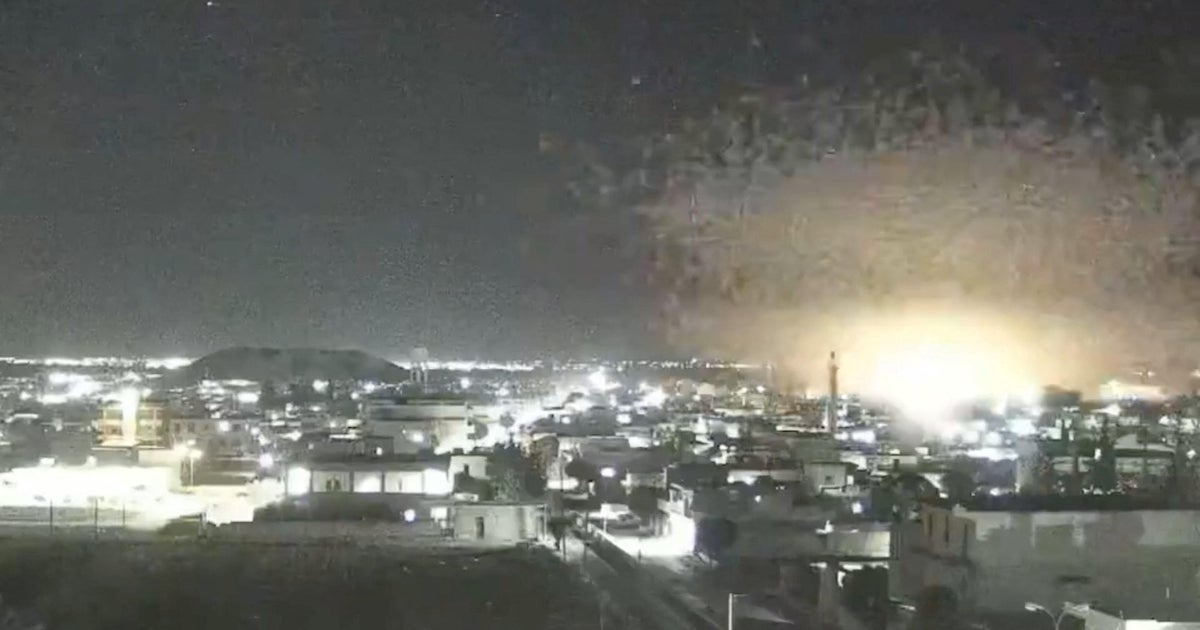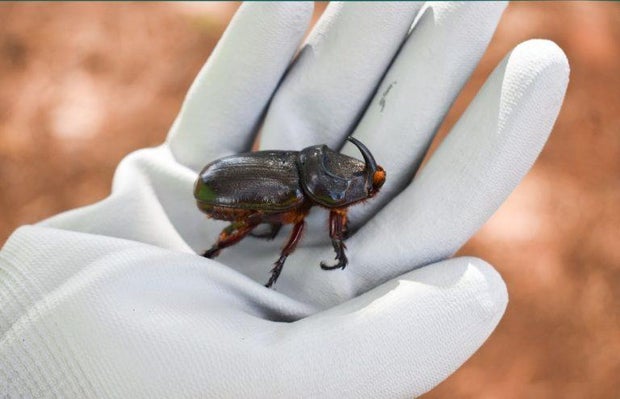CBS News
Almanac: March 31 – CBS News

Watch CBS News
Be the first to know
Get browser notifications for breaking news, live events, and exclusive reporting.
CBS News
Hawaii races to stop spread of tree-killing rhinoceros beetles, invasive species that can fly 2 miles and lay 140 eggs

Hawaii is ramping up its efforts to stop the spread of coconut rhinoceros beetles, an invasive species that has expanded its presence drastically since first being detected in the state a decade ago.
According to the state’s Invasive Species Council, the beetles — which are native to Africa, China and Southeast Asia — are about two inches long with a C-shaped body. They are nocturnal and can fly up to two miles when looking for a food source, and female beetles lay 50-140 eggs in their lifetime, which is typically four to nine months.
First found in Hawaii in 2013 at the Joint Base Pearl Harbor-Hickam, the invasive species spread across the state last year and has been detected multiple times in recent months, officials say. Coconut rhinoceros beetles do not bite but may carry disease since they live in dirt and mulch, experts say.
According to the Hawaii Invasive Species Council, the beetles can kill coconut trees, palms and other tropical crops like kalo and banana, once they bore into them, which ultimately “jeopardizes the economy, entire ecosystem, agriculture and food security.”
Hawaii Department of Natural Resources
Earlier this month, Honolulu removed an infested coconut tree at Kaiaka Bay Beach Park in an effort to control the invasive species, Hawaii News Now reported.
“It’s another sad day for us. We don’t like removing trees, especially trees like the coconut. Not only is it the ‘Tree of Life’, culturally very, very important to the Hawaiian people, so today is another sad day, and there’ll be more sad days,” said Roxanne Adams, the administrator of the city’s Department of Parks and Recreation Division of Urban Forestry.
On the North Shore, about 80 trees are slated for removal because of the beetle, the station reported.
“The unfortunate truth of this situation right now is it’s going to get worse before it gets better,” said Nate Serota of the Department of Parks and Recreation. “We’re going to have to start removing more and more of these palms, really out of concern for public safety.”
More than 100 traps have been set up around the state and regularly monitored, and earlier this month, the state designated Oahu as infested by the beetles. Under a new rule, landscaping materials such as compost, wood chips, mulch, and palms taller than four feet are not allowed to be shipped from Oahu.
Hawaii board bolsters pest control powers
The Hawaii Board of Agriculture has approved rule changes to help control the spread of invasive species following about a 20-month delay.
The holdup caused a public outcry because the rule changes are intended to help the Agriculture Department stem the movement of commodities infested by pests, including coconut rhinoceros beetles.
Once finalized, the rules will prohibit the movement of infested materials like soils and compost between islands and increase inspection requirements. They also will include specific examples of invasive species to help guide the department and industry.
Neither proponents nor opponents of the rule changes seemed fully satisfied following a Tuesday board meeting. Agriculture industry representatives called them confusing, while some proponents said they don’t go far enough.
The board members, who approved the changes unanimously, agreed that invasive species need to be better addressed, and quickly.
“This is about an all-hands-on-deck approach to managing, preventing – and hopefully eradicating – the ongoing cycle of invasive species,” Big Island board member Dianne Ley said.
That sentiment echoed messages from federal invasive species experts touring Oahu this week to research the effects of invasive species on island communities. They will produce a report to advise the U.S. government how it can help Hawaii and island territories, as well as associated Micronesian nations.
Local advocates of taking action against invasive species addressed the federal advisers Monday, pointing out the gaps in Hawaii’s response and regulations addressing the problem.
The agriculture board’s action on Tuesday was a significant step following 20 months of waiting since board chairperson Sharon Hurd pulled the proposed rule changes in the face of industry concerns.
Coconut rhinoceros beetles were detected for the first time on islands statewide in subsequent months, while little fire ants caused serious concern on Oahu’s windward coast.
Compost, soil and green waste, as well as the nursery trade, have been been blamed for the movement of those pests.
The board had approved interim rules in the meantime aimed at restricting the movement of host material for the beetles and ants.
On Tuesday, Hurd voted in favor of the permanent changes.
The newly approved rules have buoyed the hopes of environmental advocates, including Joseph Watt of the KEY Project, a Kualoa-Heeia community organization.
“I’m in strong support of these amendments; we need much stronger regulatory oversight of the movement of these materials,” Watt said.
Hawaii Floriculture and Nursery Association President Eric Tanouye on Tuesday said his membership would be more open to the rule changes as long as the agriculture department provides better guidance on how to comply. About 11 months ago, Tanouye said the revised rules would “kill agriculture.”
The rule changes, while welcome, should be the benchmark for further work to increase the department’s regulatory powers, said Stephanie Easley of the Coordinating Group on Alien Pest Species, which is affiliated with the University of Hawaii.
Additional rule changes are needed to prohibit the sale of infested plant materials, Easley told the board on Tuesday.
“Islands are a bellwether for invasive species impacts”
Questions were raised about how the department would implement the rules, considering its history of struggling to find staff and funding. The signing of Act 231 this year put about $10 million aside for the department to bolster its invasive species work and biosecurity, after lawmakers pressured the DOA to do a better job.
Ten pest control positions were created with that funding, and Plant Quarantine Branch Manager Jonathan Ho said they are in the process of being filled.
On Tuesday, board members requested that staff give monthly updates on progress in pest control, particularly as the agency works through finalizing the rules and implementing the programs under Act 231.
The rule changes will go before the Small Business Regulatory Review Board before reaching the governor’s office for a final sign-off.
Federal government officials and invasive species experts, meanwhile, are finalizing a report that will be delivered to the National Invasive Species Council, which oversees the expansion of pest management efforts nationwide and across several national agencies.
The three-day meeting in Honolulu of the federally appointed Invasive Species Advisory Committee, which includes two members from Hawaii, concludes Wednesday.
On Monday, Hawaii officials and invasive species workers and academics shared their views on Hawaii’s invasive species problems.
“We need resources, we need people and we need capacity,” said Chelsea Arnott, Hawaii Invasive Species Council program supervisor.
Representatives of the U.S. departments of Agriculture, Interior, Defense, Homeland Security and Health and Human Services were among the attendees.
The committee’s draft recommendations cover seven major areas, such as expanding federal support for island-based invasive species efforts, increasing island-specific research and infrastructure needs and addressing shortcomings in rapid response to species detections.
“Ultimately, islands are a bellwether for invasive species impacts, both nationally and globally, and are indicative of what continental communities and ecosystems may experience in the future,” the draft report states. “Accordingly, science, systems, and solutions developed to address invasive species on islands may be widely applicable across the United States.”
CBS News
Hurricane Helene’s damage, related expenses in North Carolina shattering records, estimated at $53 billion

Raleigh, N.C. — The catastrophic flooding and destruction caused by Hurricane Helene in western North Carolina likely caused at least a record $53 billion in damages and recovery needs, Gov. Roy Cooper’s administration said Wednesday.
The state budget office generated the preliminary figure for direct or indirect damages and potential investments to prevent similar destruction in future storms.
Cooper told reporters the state’s previous record for storm damage was $17 billion from Hurricane Florence, which struck eastern North Carolina in 2018.
“It is no exaggeration to describe Helene as the deadliest and most damaging storm ever to hit North Carolina,” Cooper said while unveiling his request to the General Assembly for $3.9 billion to help pay for repairs and revitalization. He called it a “down payment on western North Carolina’s future.”
North Carolina state officials have reported 96 deaths from Helene, which brought historic levels of rain and flooding to the mountains in late September.
The storm and its aftermath caused 1,400 landslides and damaged over 160 water and sewer systems, at least 6,000 miles of roads, more than 1,000 bridges and culverts and an estimated 126,000 homes, the budget office said. Some 220,000 households are expected to apply for federal assistance.
“This jaw-dropping damage figure reminds us that we are very much on the front end of this recovery effort,” the Democratic governor said.
The report with Cooper’s spending request was released the day before the Republican-controlled legislature planned to meet for a one-day session to advance additional Helene recovery legislation.
Lawmakers unanimously approved two weeks ago a $273 million package that also included language to provide flexibility to state agencies, displaced residents and officials running elections in 25 western counties. Thirty-nine of the state’s 100 counties are within the federally declared disaster area.
State government coffers include several billon dollars that can be accessed for future recovery spending. Almost $4.5 billion is in the state’s savings reserve alone.
Legislative leaders hadn’t disclosed as of late Wednesday afternoon specifics about what they would attempt to pass Thursday. Lawmakers were still reviewing Cooper’s request that they received Tuesday, according to Lauren Horsch, a spokesperson for Senate leader Phil Berger. Any legislation is unlikely to be the full package presented by Cooper and State Budget Director Kristin Walker. After Thursday, legislators are expected to return to Raleigh on Nov. 19.
The damage report projects $48.8 billion in direct or indirect damages, along with $4.8 billion of anticipated mitigation expenses. The budget office estimates the federal government will cover $13.6 billion, with private and other sources covering $6.3 billion.
Most of the losses won’t ever be recovered, Walker said.
The private-source share of expenses likely will be relatively low because so few homeowners and farmers in the disaster areas had flood or crop insurance. Close to 93% of homes with flood damage verified by the Federal Emergency Management Agency lacked flood insurance, the report said.
Cooper’s request includes $475 million for a two-phase recovery program for businesses in the hardest-hit areas, with grants from $1,500 to $50,000 in the first phase and up to $75,000 in the second phase.
Other highlights include $289 million in matching funds to access federal money to repair utilities and debris removal; $225 million for grants to farmers for uninsured losses; and $100 million for public school and community college capital needs.
Cooper also wants $325 million to help homeowners and renters with rebuilding and minor repairs immediately while a larger program dependent on federal funds is implemented. It took nearly two years for Washington to send community development block grant funding for home repairs after Florence and Hurricane Matthew in 2016, the report said.
Wednesday’s request also seeks $175 million to cover remaining Matthew and Florence home repairs being made through the block grant program. Cooper’s administration attributes the shortfall to rising construction costs, labor shortages, the COVID-19 pandemic and a congressional appropriation that was roughly half of what the state requested.
The fiscal gap prompted Berger and another leading Senate Republican to put out a news release Wednesday criticizing the $175 million request and its timing, calling them yet another sign of poor management by the state Office of Recovery and Resiliency. The senators said an oversight committee would investigate the matter next month.
CBS News
U.S.-allied Kurds in Syria say 12 killed in strikes as Turkey responds to attack on state-run defense firm

Turkey launched airstrikes late Wednesday in Kurdish-held parts of Syria and Iraq in retaliation for a deadly attack at a state-owned defense manufacturer in Ankara that saw at least two attackers kill four people and wound more than a dozen others.
The Turkish government blamed the separatist Kurdistan Workers’ Party (PKK) for what President Recep Tayyip Erdogan called a “nefarious” attack on the Turkish Aerospace Industries headquarters outside the capital.
Video verified by CBS News Confirmed showed damage to electrical infrastructure in Kobani and Qamishli, the de-facto capital of the semi-autonomous region controlled by Kurdish-majority forces in northeast Syria.
The Syrian Democratic Forces (SDF) — who were key U.S. allies in the war against ISIS in the region — said Thursday that 12 people were killed, including two children, and 25 others wounded in widespread Turkish air and artillery strikes. Turkey’s defense ministry said it struck 47 “terrorist targets” in Syria and Iraq.
Social Media/via REUTERS
SDF commander General Mazlum Abdi condemned the Turkish strikes as indiscriminate, saying they had hit civilian infrastructure, including health centers, in northeast Syria.
“We have repeatedly shown our readiness for dialogue. Meanwhile, we affirm that our forces are ready to defend our people and land,” Abdi said in a post on X.
Some 900 U.S. forces remain in the region as part of the international coalition against ISIS, and the SDF has long been America’s primary partner on the ground in northeast Syria. Neither the U.S. Defense Department nor its Central Command had commented on the attack in Ankara, or on Turkey’s retaliatory strikes, by Thursday morning.
Ankara considers the U.S.-backed SDF and its civilian body, the YPG, to be directly linked to the PKK, which has waged a decades-long insurgency in Turkey.
The PKK, long designated a terrorist organization by Turkey and the U.S., is nominally headquartered in the Qandil mountains of northern Iraq. Turkey regularly strikes the region.
No group has claimed responsibility for Wednesday’s attack in Ankara, which came at a time of renewed talks between the Turkish government and the PKK’s leader, Abdullah Ocalan, who has been imprisoned in Turkey for more than two decades.
On Thursday, Ocalan’s nephew Omer, a member of Turkey’s parliament, conveyed a message from the PKK leader suggesting he was prepared to end the violent conflict that has raged since the mid-1980s.
Erdogan ally and Nationalist Movement Party leader Devlet Bahceli had earlier invited Ocalan to address parliament, and said the 75-year-old could be paroled in exchange for disbanding the PKK.










